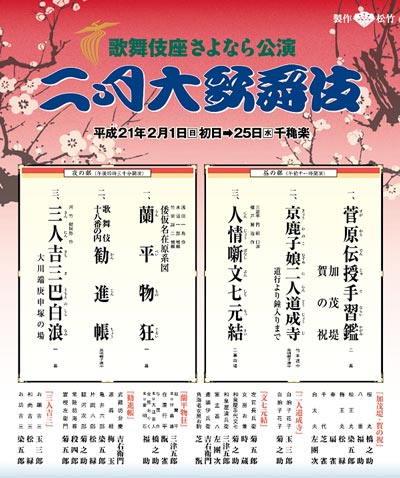| Comments |
Kenuki: in this play, which retains the light, festive atmosphere of
early-period Kabuki, a princess has a mysterious ailment that makes her hair stand
on end, an ailment that prevents her from carrying out her long-awaited marriage.
Kumedera Danj˘ comes from the groom's household to investigate and finds a plot
to take over the household when his tweezers float in mid-air.
Ichikawa Omez˘ stars in a play that features the bombastic aragoto
style of acting that is a specialty of his family.
Sagi Musume: one of the most famous dances in Kabuki, this figure is familiar through
pictures and Japanese dolls. A beautiful young woman all in white appears in the snowy landscape.
She dances lightly of love, but then reveals that she is the spirit of a bird, a magnificent heron
that struggles wounded through a snowstorm. Starring Nakamura Shichinosuke.
Abura no Jigoku: this play has become phenomenally popular in modern times for its
hard-boiled sensibility and sensuous killing scene with the protagonists
slipping and struggling through puddles of spilled oil, but was virtually ignored at the time it was written.
It shows Yohŕ, the wastrel son of a well-to-do merchant, who constantly tries to borrow money from Okichi,
the wife of a neighboring oil merchant. Pressed for funds, he tries to blackmail her,
but ends up killing her in the long, dream-like scene that gives this plays its title, "the woman killer and the hell of oil".
Starring Kataoka Ainosuke and Ichikawa Kamejir˘ in the roles of Yohŕ and Okichi.
Fubuki T˘ge: Oen and Sukez˘, an adulterous couple, have to take refuge
in a mountain hut built for pilgrims because of a violent snow storm.
Oen was the wife of the gambler Naokichi, who was Sukez˘'s boss. They fell in love
and, in order to escape death (a normal punishment for their immoral conduct),
they had to elope. They now live as fugitives, in great fear of revenge by Naokichi.
Fate has something in store for them as, this very night, Naokichi, who goes on
pilgrimage, has to shelter himself in the same hut...
Featuring Kataoka Ainosuke, Nakamura Shichinosuke and Nakamura Shid˘ in the roles of Naokichi, Oen and Sukez˘.
Sanemori Monogatari: a play about the early days of the rivalry between the Genji and Heike
warrior clans. The warrior Sait˘ Bett˘ Sanemori (Nakamura Kantar˘) has been charged by the
leaders of the dominant Heike clan with finding Aoi Gozen, the pregnant
wife of the leader of the enemy Genji clan. He is to kill her child if
it is a son who can succeed to head of the clan, but old loyalties to the
Genji lead him to protect the boy. Sanemori tells the story of how Koman,
the daughter of the old couple who is protecting Aoi Gozen, bravely fought
to protect the sacred standard of the Genji from the Heike. Koman mysteriously
comes back to life when her severed arm is rejoined to it.
Kumo no Ito: this spectacular hengemono is
about the warlord Minamoto Raik˘, who is confined to bed with illness in his palace.
His devoted retainers are on night watch. The spirit
of a spider, which has caused Raik˘'s illness in the first place, tries to enter the palace and hopes to destroy Raik˘.
The spirit of this evil spider transforms itself in different people: a tea-bringing young servant girl, a medicine peddler,
a shinz˘ and a zat˘ expert in sendai j˘ruri.
At the end, this spirit appears as the beautiful and gorgeous keisei Usugumodayű,
who sneaks in Raik˘'s sleeping room and tries to seduce him. Fortunately for Raik˘, his retainers can intervene in the nick of time
and defeat the spider, which furiously throws out streamers of long, sticky web-like threads. Starring Ichikawa Kamejir˘ in the 6 roles of this hengemono.
Featuring Nakamura Kantar˘ in the role of Minamoto Raik˘.
Source: Earphone Guide website, except "Fubuki T˘ge" and "Kumo no Ito"
|

